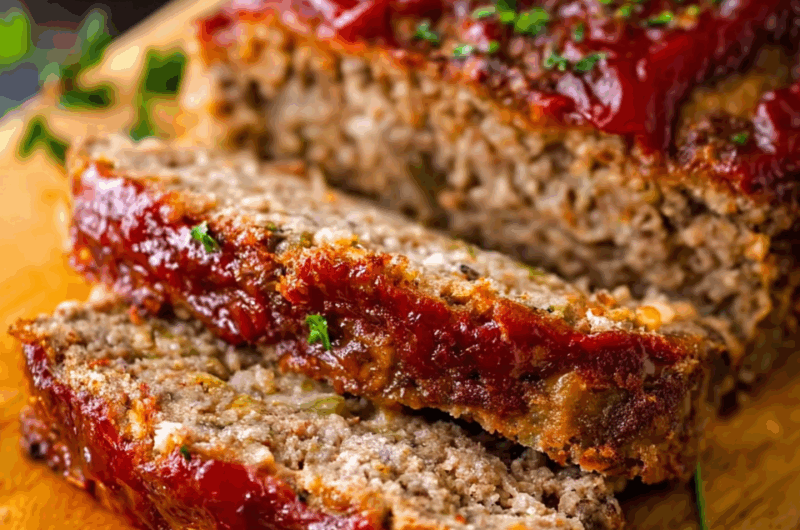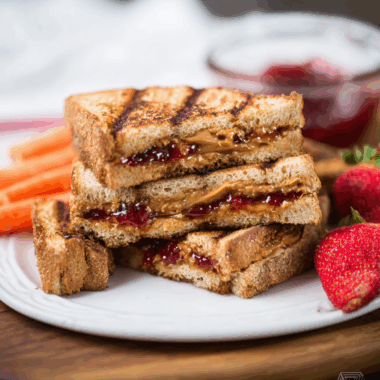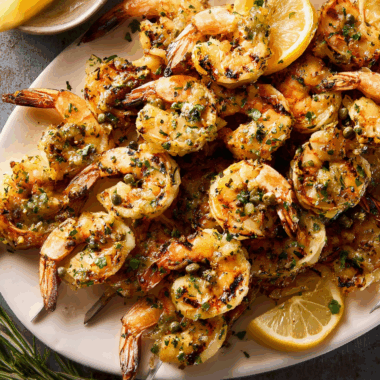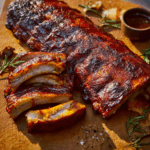The magic of this meatloaf lies in its juicy, tender texture and the punchy glaze that crowns it with tangy-sweet flavor. With grated onion worked directly into the breadcrumbs and a rich mix of herbs, bouillon, and ketchup, each slice bursts with delicious homecooked flavor.
This meatloaf is the ultimate comfort food—easy to prepare and always satisfying. It’s perfect for feeding a hungry family or meal prepping for the week. Pair it with mashed potatoes and steamed veggies, and you’ll be transported to a cozy dinner table filled with nostalgic warmth and full bellies.
Full Recipe:
-
1 cup panko breadcrumbs
-
1 large onion, grated
-
1 kg (2 lb) ground beef (not lean; 15% fat recommended)
-
2 eggs
-
3 garlic cloves, minced
-
1 tsp Worcestershire sauce
-
1/4 cup tomato ketchup
-
1/4 cup chopped parsley (or 2 tsp dried parsley or basil)
-
1 tsp dried thyme
-
2 beef bouillon cubes, crumbled (or 2 tsp beef powder)
-
1 tsp black pepper
Meatloaf Glaze:
-
1/2 cup tomato ketchup
-
2 tbsp apple cider vinegar
-
1 tbsp brown sugar, lightly packed
Directions:
-
Preheat oven to 180°C / 350°F. Lightly oil or spray a loaf pan (9×5 inches).
-
In a large mixing bowl, combine panko breadcrumbs and grated onion. Mix until the breadcrumbs are moistened by the onion juice.
-
Add ground beef, eggs, garlic, Worcestershire sauce, ketchup, parsley, thyme, bouillon, and pepper to the bowl. Mix thoroughly using your hands until well combined.
-
Shape the meat mixture into a loaf and place into the prepared pan. Smooth the top and pinch together any cracks.
-
In a separate bowl, mix all glaze ingredients. Brush half of the glaze over the meatloaf.
-
Bake for 45 minutes. Remove from oven, drain excess fat if needed, and brush with most of the remaining glaze.
-
Return to oven and bake for another 30 minutes.
-
Let the meatloaf rest for 10 minutes before slicing. Serve with mashed potatoes and steamed vegetables for a comforting meal.
Prep Time: 15 minutes | Cooking Time: 75 minutes | Total Time: 1 hour 30 minutes
Kcal: 404 kcal | Servings: 8 servings
Introduction to the Ultimate Homestyle Meatloaf
Meatloaf is one of those timeless comfort foods that bring families together around the dinner table. With its rich, savory flavor, tender interior, and glossy caramelized glaze, it’s no wonder this classic dish has stood the test of time. This meatloaf recipe, crafted by Nagi from RecipeTin Eats, has become a fan favorite thanks to its juicy texture and serious flavor boost—far beyond the bland or dry versions many people grew up with.
What makes this version extraordinary is the thoughtful combination of ingredients and techniques that elevate it from ordinary to unforgettable. It’s not just a chunk of ground beef shaped into a loaf—it’s a culinary experience that perfectly balances moisture, seasoning, and that iconic tangy-sweet glaze.
What Makes This Meatloaf Recipe Stand Out
There are countless meatloaf recipes out there, but this one is widely celebrated for a reason. It prioritizes moisture retention, depth of flavor, and texture—three factors that can make or break a meatloaf. Instead of just relying on salt for seasoning, it uses beef bouillon powder or crumbled cubes, which intensify the umami and beefiness of the dish. This is a clever twist that makes the meat more savory without drying it out.
Grated onion is another major innovation in this recipe. Rather than dicing and frying the onion separately, the raw grated onion is mixed directly into the breadcrumbs. This does two things: the breadcrumbs soak up the onion juice, adding moisture and puffing up during baking, while the onion itself blends seamlessly into the meat, infusing it with flavor without any raw crunch.
The glaze also sets this recipe apart. It’s not just ketchup—it’s a mixture of ketchup, apple cider vinegar, and brown sugar that caramelizes beautifully in the oven, adding complexity and a glossy finish that makes the dish visually appealing as well as delicious.
The Importance of Using the Right Ground Beef
One of the most common mistakes people make when preparing meatloaf is using lean ground beef. While this may sound healthier, it can lead to a dry and crumbly loaf. This recipe recommends using ground beef with at least 15% fat content. Fat is flavor, and it plays a vital role in maintaining the tenderness and juiciness of the meatloaf as it bakes.
Because this version is cooked in a loaf pan, the juices remain in close contact with the meat, helping it stay moist and flavorful throughout the cooking process. The pan also helps it hold its shape, especially when combined with the binding action of eggs and breadcrumbs.
Why the Grated Onion Technique Matters
The grated onion trick might seem simple, but it’s actually one of the most impactful methods in the entire recipe. Traditional meatloaf recipes often call for diced onions to be sautéed before being added to the meat. This extra step adds time, requires another pan, and can lead to uneven texture if not done properly.
Grating the onion not only saves time but also ensures the pieces are fine enough to disappear into the meat mixture. This means the flavor is distributed evenly, and there are no raw bits or chunks. More importantly, the onion’s juices hydrate the breadcrumbs, creating a soft, airy texture inside the loaf once it’s baked. This innovation alone makes the recipe stand out from traditional meatloaf approaches.
The Role of the Glaze
A great meatloaf glaze should be more than an afterthought—it should tie the whole dish together. In this recipe, the glaze serves several purposes. First, it provides a sweet and tangy contrast to the savory meat. Second, it locks in moisture, especially when applied at two stages during baking. Third, it adds visual appeal—the final dish has a deep reddish-brown finish that practically begs to be sliced into.
By brushing the glaze on in two phases—first before the loaf is baked, and again partway through the cooking process—you allow the flavors to build up and the surface to caramelize, creating a sticky, slightly charred outer layer that’s packed with flavor.
Texture and Slicing
Texture is crucial when it comes to meatloaf. No one wants a loaf that’s too dense or too crumbly. Thanks to the combination of breadcrumbs, grated onion, eggs, and beef with adequate fat, this meatloaf strikes the perfect balance. It holds its shape beautifully while still remaining fork-tender.
The loaf is rested for about 10 minutes after baking, which is a step you don’t want to skip. Resting allows the juices to redistribute, making the loaf easier to slice and preventing it from falling apart. You’ll notice that the first slice or two might crumble slightly—that’s actually a good sign. It means the loaf is tender, not overpacked or dry.
Meal Versatility and Leftovers
One of the best things about meatloaf is its versatility. It’s perfect as a weeknight dinner served with creamy mashed potatoes, roasted vegetables, or a simple side salad. But the magic doesn’t end there—leftovers are even better. Cold meatloaf slices can be transformed into hearty sandwiches, breakfast scrambles, or even diced and added to pasta or fried rice.
This recipe yields 8 generous servings, making it ideal for batch cooking or meal prepping. It also freezes well, both as a full cooked loaf or individual slices, allowing you to pull out a quick and satisfying meal at a moment’s notice.
Tips for Success
Here are a few bonus tips to ensure your meatloaf turns out perfectly every time:
-
Use a loaf pan: It helps the meat cook evenly and stay juicy. Free-form loaves can dry out at the edges before the center is done.
-
Don’t skip the glaze: It adds flavor and a beautiful finish.
-
Avoid overmixing: Combine the ingredients thoroughly but gently. Overworking the meat can lead to a dense, tough loaf.
-
Let it rest: Allowing the meatloaf to rest before slicing is essential to maintaining structure and keeping juices locked in.
Serving Suggestions
This meatloaf is a standalone star, but it truly shines when paired with traditional sides. Creamy mashed potatoes are the classic accompaniment—rich, fluffy, and perfect for sopping up any glaze or juices. For a lighter touch, consider serving it with:
-
Cauliflower mash
-
Steamed green beans or broccoli
-
Roasted root vegetables
-
A crisp garden salad
-
Crusty bread to mop up sauces
To add variety, consider drizzling a little extra glaze or even a homemade gravy over each slice before serving.
Nutritional Considerations
Each serving of this meatloaf clocks in at around 404 calories, with 24g of protein and a balanced mix of carbohydrates and fats. The use of panko breadcrumbs and fresh herbs makes it lighter in texture, even if it’s still rich and indulgent in flavor.
For those looking to make it a bit healthier, you can substitute ground turkey or chicken, use low-sugar ketchup, or add grated vegetables like zucchini or carrots to the mix. However, keep in mind that changing the type of meat will affect the moisture and flavor.
Conclusion: Why This Meatloaf is a Must-Try
This recipe is not just a meatloaf—it’s a blueprint for comfort food done right. With thoughtful ingredient choices, clever techniques like grating the onion, and a rich, flavorful glaze, it transforms a humble dish into something extraordinary. It’s satisfying, easy to make, and versatile enough to serve at a family dinner, casual gathering, or as meal prep for the week.
Whether you’re new to making meatloaf or looking to improve your current recipe, this version is guaranteed to impress. It’s juicy, tender, flavorful, and delightfully nostalgic—all the best qualities of a classic homestyle meal in one dish.








